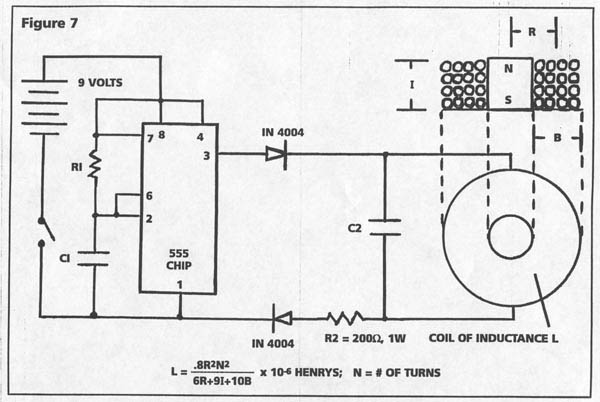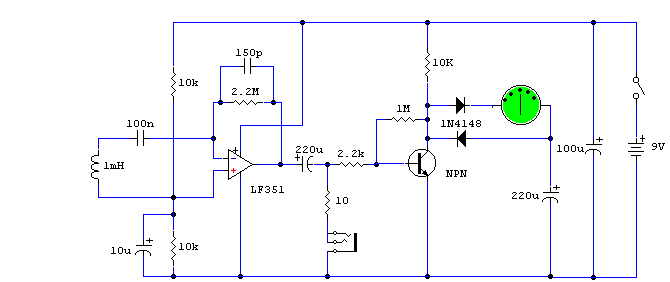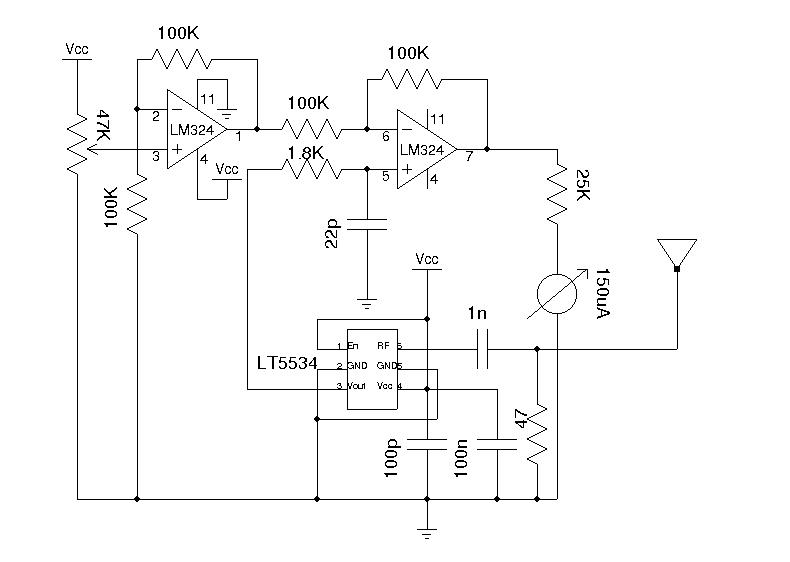
Electromagnetic field detectors

This circuit is a valuable tool that is easy to assemble and demonstrates greater sensitivity than many commercial devices. It utilizes an LF351 low-noise operational amplifier and a 1mF choke as the sensor. Unlike most basic EMF detectors, this circuit features a meter output for precise readings, and it also allows for a rough estimation of the frequency of the field by connecting headphones. It can detect electromagnetic fields ranging from 50Hz to 100kHz, which enhances its versatility and makes it a beneficial addition to any hobbyist's workbench.
The circuit design primarily revolves around the LF351 operational amplifier, which is known for its low noise characteristics, making it suitable for detecting weak electromagnetic fields. The operational amplifier is configured in a non-inverting amplifier arrangement to amplify the signal received from the sensor. The 1mF choke serves as the sensing element, responding to variations in electromagnetic fields by generating a corresponding voltage output.
The output from the operational amplifier can be fed into a standard analog meter, providing a visual representation of the detected electromagnetic field strength. This feature allows users to obtain accurate measurements, which is crucial for various applications, including electromagnetic field analysis and troubleshooting electronic devices.
Additionally, the circuit provides an alternative method for frequency estimation through the use of headphones. When headphones are connected, the circuit generates audio signals corresponding to the detected electromagnetic frequencies, enabling users to hear the variations in the electromagnetic field. This auditory feedback can be particularly useful for identifying specific frequencies of interest without the need for additional equipment.
The operational amplifier's gain can be adjusted using external resistors, allowing for customization based on the specific requirements of the application. The circuit can be powered by a standard DC power supply, ensuring compatibility with a wide range of power sources.
Overall, this EMF detector circuit is designed to be user-friendly and efficient, making it an excellent choice for hobbyists and professionals alike who require a reliable tool for electromagnetic field detection and analysis.This lovely circuit is a real gem! Easy to assemble and more sensitive than many commercial devices available. It`s based around an LF351 low-noise operational amplifier and a 1mF choke acting as the sensor. Unlike most other simple EMF detectors, this one has a meter output for accurate reading, but alternatively, you can also roughly estimate th e frequency of the field by plugging in headphones. It can detect any field from 50Hz to 100kHz, making it highly versatile and a worthwhile addition to any hobbyist`s workbench. 🔗 External reference
The circuit design primarily revolves around the LF351 operational amplifier, which is known for its low noise characteristics, making it suitable for detecting weak electromagnetic fields. The operational amplifier is configured in a non-inverting amplifier arrangement to amplify the signal received from the sensor. The 1mF choke serves as the sensing element, responding to variations in electromagnetic fields by generating a corresponding voltage output.
The output from the operational amplifier can be fed into a standard analog meter, providing a visual representation of the detected electromagnetic field strength. This feature allows users to obtain accurate measurements, which is crucial for various applications, including electromagnetic field analysis and troubleshooting electronic devices.
Additionally, the circuit provides an alternative method for frequency estimation through the use of headphones. When headphones are connected, the circuit generates audio signals corresponding to the detected electromagnetic frequencies, enabling users to hear the variations in the electromagnetic field. This auditory feedback can be particularly useful for identifying specific frequencies of interest without the need for additional equipment.
The operational amplifier's gain can be adjusted using external resistors, allowing for customization based on the specific requirements of the application. The circuit can be powered by a standard DC power supply, ensuring compatibility with a wide range of power sources.
Overall, this EMF detector circuit is designed to be user-friendly and efficient, making it an excellent choice for hobbyists and professionals alike who require a reliable tool for electromagnetic field detection and analysis.This lovely circuit is a real gem! Easy to assemble and more sensitive than many commercial devices available. It`s based around an LF351 low-noise operational amplifier and a 1mF choke acting as the sensor. Unlike most other simple EMF detectors, this one has a meter output for accurate reading, but alternatively, you can also roughly estimate th e frequency of the field by plugging in headphones. It can detect any field from 50Hz to 100kHz, making it highly versatile and a worthwhile addition to any hobbyist`s workbench. 🔗 External reference





